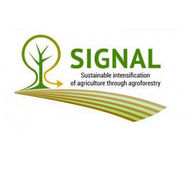Alley cropping tree lines alter temperature and light quantity and influence daily growth rates of grassland (2023)
Sutterlütti R., Kayser M., Komainda M., Isselstein J.
Grass and Forage Science, 78 (3), 402-415
Abstract
AbstractTrees alter microclimate and radiation budget in alley cropping systems, which in turn change physiological processes of the grassland component. The influence of the trees on grassland growth depends on the climate zone as well as possibly on weather conditions during the respective growth interval. The proportion of shade‐tolerant species in the grassland further modifies the tree effect on grassland growth, as well as the number of annual harvests. We studied the effect of distance and orientation relative to the tree line (tree line in the South‐West vs. North‐East) on growth rates of the adjacent grassland with two cutting frequencies (frequent vs. infrequent) in an alley cropping system with grassland of two different vegetation compositions (diverse vs. grass‐clover) and willow clones. Microclimate parameters and radiation were measured at the points where growth rates were determined to better characterize the effect of position relative to the tree line. Growth rates differed significantly (p < 0.05) depending on the distance to the trees and annual biomass accumulation amounted to 389 ± 13.5 g m−2 in the center vs. 321 ± 10.0 g m−2 with trees in the North‐East vs. 292 ± 9.2 g m−2 with trees in the South‐West of the transect position. Lower growth rates occurred at positions with lower light quantities close to the trees, namely the position with the trees adjacent in the South‐West. Temperature and relative humidity differences between the distances were significantly (p < 0.05) affected by distance to the tree line, but differences in neither soil nor air temperatures between the distances affected growth rates. Vegetation composition mediates the influence of the trees: the difference between positions was more pronounced in the diverse vegetation composition with higher productivities in the center between the alleys, but also with higher overall sward productivity.